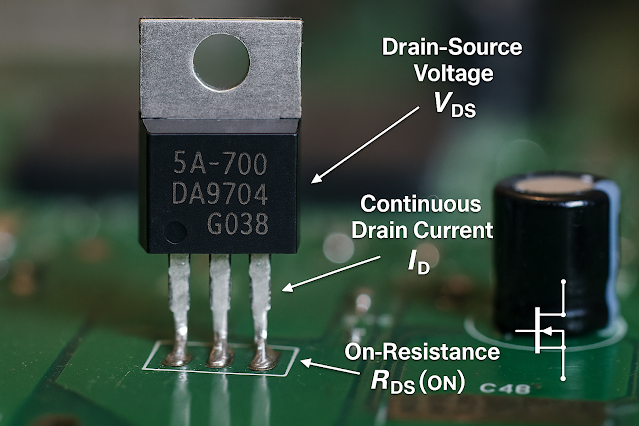In this comprehensive guide, you’ll learn:
✅ The key parameters to check in a MOSFET datasheet
✅ How to match MOSFET characteristics to your circuit requirements
✅ Real-world design examples and pitfalls to avoid
✅ FAQs to clear up common selection mistakes
✅ What is a MOSFET and Why is Selection Important?
A MOSFET acts as an electronic switch or variable resistor controlled by a gate voltage. Picking the wrong MOSFET can lead to:
- Excessive heat generation
- Low efficiency
- Signal distortion or noise
- Circuit failure under load or voltage spikes
Understanding the core specifications and trade-offs helps you choose a transistor that performs optimally in your specific application.
✅ Key Parameters to Consider in MOSFET Selection
1️⃣ Drain-Source Voltage (VDS)
What it means:
The maximum voltage the MOSFET can block from drain to source when it’s off.
How to use it:
Choose a VDS rating that is at least 20–30% higher than your circuit’s peak operating voltage to ensure safe margin against spikes.
Example:
For a 24 V motor driver, choose a MOSFET with VDS ≥ 30 V.
2️⃣ Continuous Drain Current (ID)
What it means:
Maximum drain current the MOSFET can handle continuously at a specified temperature (typically 25°C).
How to use it:
Estimate your maximum load current and pick a MOSFET with ID comfortably higher. Don’t forget to account for derating at higher temperatures.
Example:
If your load draws 10 A max, select a MOSFET with ID ≥ 15 A.
3️⃣ On-Resistance (RDS(ON))
What it means:
The resistance between drain and source when the MOSFET is fully turned on.
How to use it:
Lower RDS(ON) means lower conduction losses (I²R losses) and less heat. Especially important for high-current applications.
Example:
For battery protection switches, look for MOSFETs with milliohm-level RDS(ON).
4️⃣ Gate Threshold Voltage (VGS(th))
What it means:
The gate-to-source voltage at which the MOSFET just starts to turn on.
How to use it:
This helps you know whether your circuit’s gate drive voltage is sufficient to fully enhance the MOSFET. For logic-level MOSFETs, VGS(th) is low enough to be driven directly by 3.3 V or 5 V logic.
Example:
For Arduino PWM circuits, choose MOSFETs with VGS(th) ≤ 2 V and test that the MOSFET fully enhances at your actual drive voltage.
5️⃣ Gate Charge (QG)
What it means:
Total charge needed to switch the gate from off to on.
How to use it:
Affects how quickly you can switch the MOSFET and how much power is wasted driving the gate. For high-frequency switching, look for low QG.
Example:
For switching at 100 kHz in a buck converter, a low QG minimizes switching losses.
6️⃣ Package and Thermal Resistance (RθJA, RθJC)
What it means:
Indicates how well the MOSFET can dissipate heat. Surface-mount MOSFETs (like PowerPAK, D2PAK) often have excellent thermal performance.
How to use it:
Calculate power losses:
- Conduction loss: Pcond = ID² × RDS(ON)
- Switching loss: Psw = ½ × VDS × ID × tsw × fsw
Ensure the total power loss does not exceed the package’s thermal capacity.
✅ Real-World Examples
Example 1: Low-Side Switch for a 12 V LED Strip
Requirements:
- VDS ≥ 20 V
- ID ≥ 5 A
- RDS(ON) ≤ 50 mΩ
- Logic-level gate drive with VGS(th) ≤ 2 V
Popular choice: IRLZ44N, AO3400, or SI2302 for small loads.
Example 2: High-Frequency DC-DC Converter
Requirements:
- VDS ≥ 40 V
- Low RDS(ON) ≤ 5 mΩ
- Low QG to minimize switching losses
- Good package for heat sinking (e.g., TO-220 or LFPAK56)
✅ Other Practical Tips for MOSFET Selection
- ✔️ Always cross-check the gate driver capability.
- ✔️ Use snubber circuits or Zener diodes for voltage spike protection.
- ✔️ Paralleling MOSFETs is an option to share current — but pay attention to thermal and current sharing.
- ✔️ Check the body diode characteristics for synchronous rectification.
- ✔️ For high-voltage applications, choose devices with robust avalanche ratings.
✅ Common Mistakes to Avoid
- ❌ Using VGS(th) as the full turn-on voltage — always check RDS(ON) at your real gate voltage.
- ❌ Ignoring heat dissipation — a MOSFET with perfect specs can still fail if it overheats.
- ❌ Overlooking gate drive requirements — weak gate drive means slow switching, more heat, and EMI.
✅ FAQs: Choosing the Right MOSFET
Q1: Can I use any MOSFET for logic-level switching?
Not necessarily! Many MOSFETs need ≥ 10 V to fully turn on. Look for “logic-level” in the datasheet and check RDS(ON) at your gate voltage.
Q2: What happens if my MOSFET’s VDS rating is too low?
It may break down and fail when voltage spikes occur — always leave margin.
Q3: Should I choose the lowest RDS(ON) possible?
Usually yes, for power stages — but keep an eye on higher gate charge that can make switching slower and more lossy at high frequencies.
Q4: What if my MOSFET gets too hot?
Improve heatsinking, pick a MOSFET with better thermal resistance, or switch to multiple MOSFETs in parallel.
✅ Key Takeaways
- ✅ Always read the entire datasheet — not just a single spec!
- ✅ Match VDS, ID, and RDS(ON) to your application with proper safety margins.
- ✅ Consider gate drive strength and switching frequency to minimize losses.
- ✅ Plan for heat dissipation — thermal design is just as important as electrical.
- ✅ Using proper MOSFET drivers and PCB layout can make or break your design.
📚 Final Words
The right MOSFET can make your design efficient, robust, and cost-effective — but the wrong choice may lead to headaches and failures. Use this guide to pick the best device for your circuit, verify with calculations, and test your design thoroughly.

